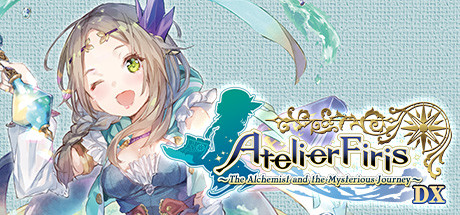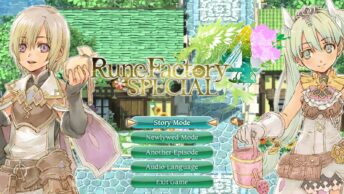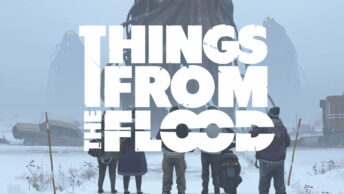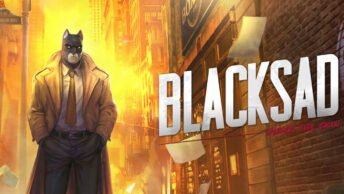The Atelier title that started me on my journey to becoming a proficient alchemist, the first Atelier title I recall playing is back in a DX package. It is once again time to stir up an Adventure!
Type: Single-player
Genre: RPG
Developer: KOEI TECMO
Publisher: KOEI TECMO
Release Date: 21 Apr, 2021

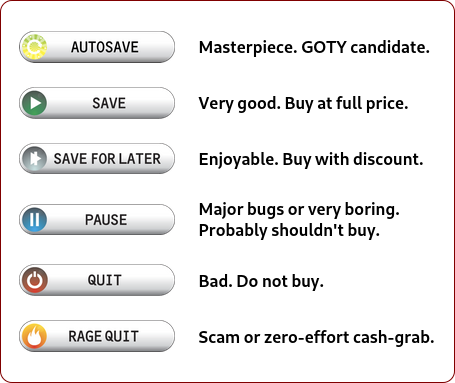
Reviewer’s Note
I actually reviewed Atelier Firis: The Alchemist and the Mysterious Journey before for Save or Quit, but I have been looking for an excuse to replay Atelier Firis since it was the first Atelier title that I played. Now that I have played the games that have come before and after it, it is time to see if my fond memories of Atelier Firis were founded or not! Since the game was reviewed before, rather than reinvent the wheel, some of the previous review is presented here. I have interjected and updated it to reflect the DX version as well as updated the opinions presented.
Literally Living under a Rock
Atelier Firis: The Alchemist and the Mysterious Journey DX is the second entry in the Mysterious Saga trilogy arc of the long running Atelier series. This time the game stars Firis, a young woman who lives inside a sealed city deep within a mountain, who longs to go outside. However, with the outside world being such a dangerous place, her mother forbids her from being able to venture outside their sealed town. One day a mysterious alchemist suddenly appears in a rather violent fashion by blowing a hole through the door protecting the subterranean town. Firis who happened to be standing by the door was awestruck (also nearly door struck!) and is quickly enamored by Sophie’s abilities to both destroy and repair the door almost magically. Sophie takes Firis under her wing to teach her the mysterious ways of alchemy. Due to her seemingly innate aptitude with Alchemy, Firis is given just one chance to go outside. Firis finds herself embarking on her own Mysterious Journey to prove to her worth as a budding alchemist and earn her freedom!
Atelier Firis: The Alchemist and the Mysterious Journey DX at its core is a turn-based, Anime styled, 3D Japanese Role Playing Game. The core mechanics involve Firis working in her Atelier (Alchemist Workshop) at her cauldron where she is mixing new items into existence. This will likely be your primary source of items in the game as money is a bit tight starting out. You don’t really have time to grind for materials or money as the entire first half (or if you do terribly, through the entire game) is set against a time limit. Failing to reach your destination or failing the quest once you get there will force Firis to go back home and live forever trapped in the sealed city. She will only be able to dream of the time she was once allowed to go outside. Fortunately, assuming you have some time management skills and don’t get lost too often, you should make it to your final destination with plenty of time to spare. If you are a little bit careful, the time limit really doesn’t impact gameplay that much, it just keeps you from over-exploring or grinding out too many levels/materials/items too early on.

Gameplay
As mentioned previously, you have a time limit in this game. While not overly restrictive, it does make the game feel a bit rushed during your first playthrough. You really don’t know how long it will actually take you to get where you are going. You will probably suffer the seemingly ever-present nagging fear that you might have wasted too much time doing the various diversions and side quests available. The world map is broken into various zones, and within each zone are various side quests presented to you to complete in order to earn extra ideas, items and money. Within each zone there are also places where you can set up your Atelier in order to craft up any materials you have found, rest and save your game. Resting is highly important as it not only refills your health and magic power, it also restores your exhaustion. Exhaustion occurs as Firis wanders around and collects things in the world. Some things, such as mining, are more exhausting than others. There are also points of interest around the various zones that act as fast travel markers which will save you the effort of walking back and forth through the various areas, however, you still incur the travel exhaustion costs. I know I frequently became lost during my trek since while the overall map indicates approximately which way you should be heading to get to the destination city, the zones are not marked on the map until you have encountered them. Additionally, the maps of the various zones do not exist until you make them yourself through your own exploration of each area. This can lead you to take the wrong path and end up in the wrong next zone and add significant time to your journey. One thing that was mildly annoying, and eventually there is a way to avoid it, is the fact that if you wanted to revisit an area, you have to pass through each of zones between where you are and where you want to go again. It would have been nice to have a fast travel to previous areas option, but since I really did not find myself backtracking that much, it was not that bad.
As you explore the various zones, you will quickly learn of the time of day system. During the day, businesses and homes are open and in typical JRPG/Adventure game fashion, you can barge right in and have the occupants of the private homes perfectly civil and happy to see you… unlike what happens in real life when you do that, but that is a story for another time. At night however, people sensibly do not let you into their homes and businesses close. The night actually has something more interesting to offer than being left out in the cold. That, as you will find out, is that the monsters roaming the world change somewhat. There are night time exclusive monsters for you to hunt! Day and Night cycles are always a nice touch in these sorts of games where permanent noon is generally the norm. Another great feature you will notice is the fact there is also the weather system. It can go from a nice warm, sun shiny day to a miserable rainy day or dull, foggy day seemingly at random. It is just like in real life! Rain will fall from the sky, visibility reducing fog will roll in, sand and snow storms will impact movement and visibility and so on. The weather system isn’t just some cosmetic flare however as some items and quest fulfilment require certain weather conditions to be in place. This makes the Atelier Firis experience all the better although it can be mildly frustrating when the weather refuses to cooperate with you. Doesn’t it know I have a deadline?!

Each of the zones has an overarching theme. While not listing them all, I will let you know a few of them. The most beautiful in my opinion are the forests, tall trees everywhere casting long shadows over the ground. As the sun moves across the sky, the shadows slowly move with it, the sun/shadow relationship is very realistic in this game. It’s also a very heavy graphical resource load so if you have a bit of a weaker computer, you might find yourself enjoying it with reduced frames per second, but most of the time the impact isn’t that noticeable. The only time the frames per second dropped painfully low for me was when the fog rolled in to a heavily monster populated forest. The sandy desert which is prone to sand storms and the frosty snow zones and its snow storms were also both very nicely done. The desert was full of animal bones for you to harvest and the snow zone had snow covered items. These unique touches really do help make each zone feel different and show that a lot of thought and work went into making the game.
Each zone has its own materials to harvest as well as some of the other common items you need. This encourages you to actually explore any zone you are able to explore, especially after you successfully complete the first half of the game and the time restriction is lifted. Each zone generally has at least one cave to search as well. Often times you will find a treasure chest and/or new materials inside a cave and perhaps even some different monsters. Here is the thing about caves though, they tend to be quite dark. Luckily one of the first things you are able to craft is a lantern that will remove any visibility issue you might encounter in the cave. Speaking of monsters, generally all battles can be avoided as you can see the monsters on the map and can easily avoid them. Some of those enemies you will have to really think about if you want to get near or if you want to give them a wide berth as their skull and crossbones symbol isn’t telling you that they are a mighty pirate, but it is telling you that they are quite mighty! These boss fights often give very lucrative spoils of battle, however, they can easily lead to a party wipe-out if you are not careful, and sometimes, even if you are being careful. The basic idea here is that when you first go to a new area, unless you are finding the regular monsters easy to kill, avoid the bosses until you return to that area.

Battles in this game, as mentioned are turn based, and whose turn it is mostly based on their speed. Faster characters/enemies get their turns first, the slower characters/enemies have to wait a bit. This can lead to some bosses pretty much wiping your team before you even get a chance to move. It also means you have to pay attention to the turn order list on the right side of the screen, as you might be able to focus on the enemies in such a way that you can delay their turn a while or even kill them before they can attack you. Attacks can be made using your equipped weapon or your skills/abilities/items. Here is where the strategy comes into play. Each weapon you make or find comes with abilities they will lend to their owner. This means that even though you acquired a higher tier of your primary weapon, it doesn’t mean you should rush to equip it. You need to compare the abilities you will gain to the ones that you will lose to see if it will be worthwhile. Luckily, you can equip two weapons to most of the characters so that if there are bonus abilities/effects/skills/traits you just can’t live without (such as magic/health regen) you can equip a secondary weapon that has those bonuses. The same goes with your armor and accessories, just because the new one offers a little more defense, the bonuses you lose might not make it worth your while.
Getting back into the battle basics, some of the abilities you have actually can have their effect occur multiple times. This can really help turn the tide of battle as it’s like an extra attack thrown in for good measure even if the original instigating character is dead. If you are out of magic, you can also use some of the items you crafted as weapons. In all battles, you need to pay attention to the resistances of your enemies. Just because an item/spell was super effective last time you used it, doesn’t mean it will be every time. Some monsters are weak to certain things while others have high resistance to the same thing. This leads you to have to plan your battle to maximize your damage. Depending on the item or spell, it is possible to hit multiple enemies with a single move. There is another aspect of the battle I would be remiss if I didn’t mention. Chaining together non-basic attacks, will lead a gauge on the left side to fill. Filling this gauge will lead to chain sequence starting. Chaining together enough non-basic attacks will lead to chain bonus effects kicking in, which include extra powerful finishing attacks. This leads to the general rule of thumb, don’t whack it with your weapon unless you have exhausted all other options!

As for looks, the characters in the game all are dressed quite nicely. It’s also possible to change some of their clothing as well. Firis, for example, has quite a few wardrobe choices available to her. The nice thing about that isn’t just that it makes her character look completely different with each dress change, it’s the fact that outfits have special effects too. Some improve her alchemy, others reduce her exhaustion rate as she explores the world, there are plenty of others available. You can have up to four characters in battle at a time. Their position on the battlefield impacts how much attention they will get from the monsters so you will want to ensure your best defensive geared character is always front and center, your damage dealers to the side, with Firis hiding in the back. Despite position system, any weapon can hit from anywhere meaning that the class weapons really only impact what abilities/spells the character can have rather than the their attack range.
Another thing about the characters is that they are all fun to be around. Thankfully you can keep some of them in your Atelier with you and the rest you can easily visit or swap in/out of your party at the Inns in each of the towns. Keeping them in your Atelier makes it easier to get friendship points with them which in turn unlocks more content with that character as well as new skills. Friendship is gained through short dialogue exchanges between the characters where Firis gets to know them better. Sometimes they will give you a gift, teach you a new recipe or send you on a quest so it is a good idea to rotate the characters through your Atelier in order to maximize friendship with each of them. This unfortunately means you will sometimes be dragging a weak character with you into battle. All is not lost though as they will quickly catch up on the rest of the team level wise after only a few battles. The game is incredibly good at ensuring under leveled characters do not remain that way for long.

Alchemy is something incredibly important to this game so it might seem a bit weird that we are so far into this review and yet have barely mentioned it. I did that for a special reason. Alchemy, as defined by the Atelier series, is like cooking soup. You mix in all the ingredients into the cauldron, stir it a few times and out pops a brand-new item. It isn’t quite that simple though. When designing the item, it will require key items. Sometimes they are very specific, needing a precise item to fulfill the requirement, but most of the time any item of the general item class will do. Each item has a quality level, an associated colour or colours, size, shape and traits. Just because both items have the same name, doesn’t mean they are necessarily identical. When it comes to making an item, careful attention to the item should be paid. Each item has potential bonus traits which will either enhance or damage the outputted item. Some of them will even add additional abilities to the item output. An example is the lantern. The basic lantern is all you need to see in a cave. With some careful crafting, it can let you see even further. There are generally multiple tiers for each of the colour bonus lines, so careful selection of inputs can maximize the output potential. When you are actually mixing the items together, you have to place them onto a grid. You could just place them randomly but there are bonus lines available that can help enhance your end results. Often times you need to craft items in order to make other items. This leads you to have to carefully balance the quality of the items you make. This is to ensure that the items you really need have the highest possible quality. The not so important alchemy level stepping stones or cosmetic items can use the lower quality items.

The last point of alchemy I need to mention is the recipe system. As you do various actions in the game, you will gain recipes and new ideas. Harvesting enough of a certain plant will likely make Firis think up a new item she can make with it. Sometimes this can be a bit painful as it might require you to find or make a ton of an item before it triggers. Sometimes the item you need is from an earlier area and it is quite a trek to go back for it, other times you will have no idea where the item you need is because you have not encountered it yet. Luckily, there are idea points to solve this problem. As Firis completes quests she will gain idea points. These points can be used to unlock almost any recipe without fulfilling the discovery requirements for it. You shouldn’t just spend these points freely though as sometimes you are better off just waiting for it to naturally unlock. This is especially true if you don’t have the materials to make it already. Alchemy is incredibly time consuming both in the need to source the items you will use as well as the time it takes Firis to make the item. If you do not carefully watch the clock, you can easily find yourself without enough time to finish the first part of the game.
The last thing I will mention about the gameplay is in fact the ultimate destination of the first half of the game. Once you reach the city and are ready to take the exam, you will find that getting an Alchemy License is actually serious business. The exam, which you actually have to take, involves you having to answer a set of multiple choice questions about alchemy and the game in general. If you plan to cheat here, you really can’t as you have a very short time limit before you auto fail the question. The next phase involves you having to craft something of high quality within a time limit as well. Believe it or not and what makes it even more fun is, in order to do well and get your Alchemy License, you will actually have to study as if it were a real-life licensing exam!

Graphics
As mentioned earlier, each zone has its own distinct feel to it. There is a lot of attention to detail going on and almost everything looks beautiful. The fact the shadows move with the sun is quite an impressive attention to detail which really shows they tried hard to really pack as much visual quality into the game as they could. Each of the characters is wearing highly detailed and distinct looking outfits that really help to enhance the enjoyment of the game. While there are zones that look very similar to other zones, there are enough distinctions between them as to make it not feel like they were just copy and pasted assets. Each of the cities has their own design which certainly helps enhance the feeling that you actually are truly on a world spanning adventure. The first town is set inside a mountain, the next is prairies with farmland, and yet another is nestled on the shores of a lake. There are plenty of towns to visit, but none are as impressive as your destination city, at least not in terms of size!
There are a variety of enemies available in the game although quite a few of them are just recolours. There is nothing really wrong with recolours mind you, the real world works that way too. There were enough enemy varieties around that it felt more like the recolours were caused by the species adapting to its environment rather than a lack of creativity on the developer’s part.
Audio
The dialogue in this game is delivered in a mix of spoken word and displayed text. When the characters are talking each one sounds distinct and you can easily read the character’s personality from it. What is also nice about this is sometimes the characters will randomly say things when you visit an area or the time of day/weather changes. Unfortunately, they tend to repeat themselves a lot, but that is okay too. The music in the game is all very whimsical and enjoyable and fits the mood of the game completely. The sound effects are more generic, but when it comes to the sound of swinging a weapon or pickaxe there is really only so much embellishment you can do for that action.
Controls and User Interface
The controls of this game work quite well. I mostly used a gamepad to play it and I never once found myself having any difficulty figuring out how to do something nor had any issues making the game do what I intended. The menus are all easy to navigate, and the on-screen prompts generally coincided nicely with what button presses I needed to do in order to access what I needed. The keyboard works for the game as well but my experience with that was more limited. I was able to easily figure out the correct keystrokes to perform most actions.
The only real complaint I have about the User Interface is the fact that the tasks did not always display properly in the log. The game gives you hints/clues towards how to solve the particular task in case you get stuck, but sometimes these hints are completely unrelated to the task at hand. Being someone who has played the game before, I could recognize the problem, but someone brand new to the game might get completely baffled and stuck trying to follow the clue it gave. The clues appear to be for a much later task you will have to do rather than the one currently displayed. You can still do the task though, just you will have to figure it out for yourself.

DX Differences
The original Firis had quite a few graphical issues, however, those appear to have been fixed for the DX version. Technically, the graphics were a little better in the original, but the shadows and other effects no longer bog the game down and actually work as intended.
One thing I left out of the review last time I talked about this game was the post-game content. I did not want to spoil the fact there was an airship you acquire there that is a real game changer. Now with the DX version there are additional vehicles and exploration tools available to help Firis on her journey. These can be quite interesting to use!
Similar to the other Mysterious Trilogy DX games, previous DLC has been included in the DX version. This actually adds a lot of interesting content to the game. It also includes a fast forward feature to help speed up battles and the photo mode for taking ideal screenshots. Another new feature is a new quest for Firis to take on that will have her battling some pretty tough foes.

Verdict
So, should you get Atelier Firis: The Alchemist and the Mysterious Journey DX? If you enjoy JRPGs with anime-style graphics and characters, then I think you would likely enjoy Atelier Firis: The Alchemist and the Mysterious Journey DX. The combat in the game is not that heavy and can be avoided mostly so if you are looking for a fun and imaginative story about lovable characters going on an adventure, then I think this is definitely one you should consider. Having replayed Atelier Firis after all these years, it was still an enjoyable experience for me and really helped me appreciate Atelier Ryza which is kind of a spiritual successor to Atelier Firis. While Atelier Firis is the second in the Mysterious trilogy and eighteenth overall in the Atelier series, it can easily be used as your first Atelier game as it was for me back in the day.

